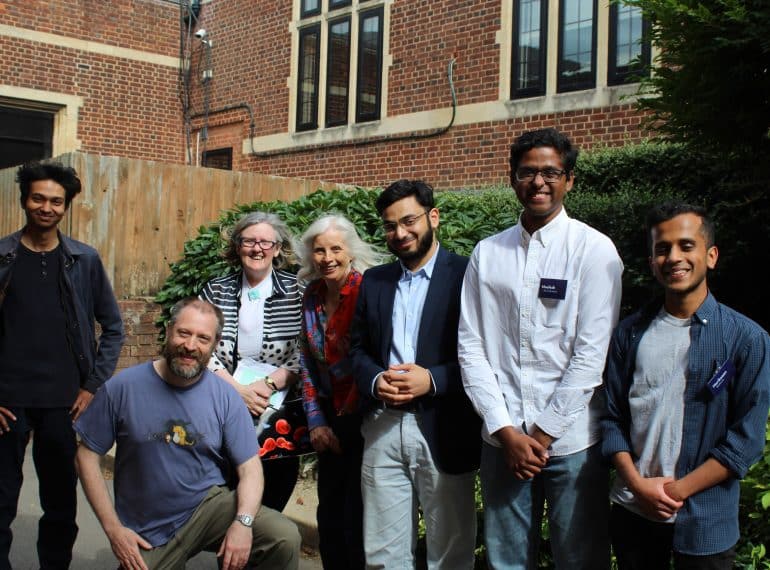
Old Elizabethans helped 50 boys battle it out in a Galactic Challenge at the School that saw all three teams secure multi-billion pound contracts for an imagined settlement in space.
The pupils from Years 7–9 (and from across tutor groups) formed aerospace ‘companies’ to participate in the space industry simulation challenge, competing against not only each other but also the clock. Their target was to design a space station for 100 years hence, when space travel might be commonplace. The remit was for a tourist resort that would orbit Mars.
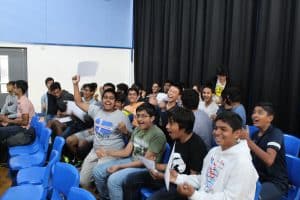 Lending their expertise and experience on the day were four 2017 leavers: Aadil Kara, Neelesh Ravichandran and Harikesan Baskaran and Suchira Peiris. Aadil, Neelesh and Harikesan all got through to the national stages of the UK Space Design Competition (Galactic Challenge’s ‘big brother’ for older pupils) when they were in Year 13, with Aadil going on to reach international level.
Lending their expertise and experience on the day were four 2017 leavers: Aadil Kara, Neelesh Ravichandran and Harikesan Baskaran and Suchira Peiris. Aadil, Neelesh and Harikesan all got through to the national stages of the UK Space Design Competition (Galactic Challenge’s ‘big brother’ for older pupils) when they were in Year 13, with Aadil going on to reach international level.
Jonathan Brooke, Head of Physics, has been impressed by how the OEs have sustained their commitment to STEM outreach throughout their undergraduate studies and beyond: “It’s even more impressive to see this commitment continue as they move into challenging careers and post-graduate study,” he said.
“They were the driving force behind digital Galactic Challenge competitions that were a welcome diversion to our boys during lockdown, and it was an honour and a pleasure to welcome them back to the School to host an in-person competition.”
Mr Brooke was also thanked the Year 12 boys who helped on the day. “Without them, the event could not have run so smoothly.”
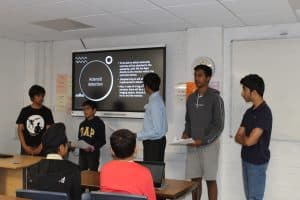 The challenge has two main objectives: to help foster pupils’ interest in Science, Technology, Engineering and Mathematics (STEM), and to help them develop so-called ‘soft skills’, such as team-working, communication, and the ability to solve complex problems.
The challenge has two main objectives: to help foster pupils’ interest in Science, Technology, Engineering and Mathematics (STEM), and to help them develop so-called ‘soft skills’, such as team-working, communication, and the ability to solve complex problems.
Aadil, who studied Physics at Imperial College London and now works as a data analyst for the Civil Service, said: “It was a joy to see the teams rise to the challenge, and to work productively in a way that rivals some professional teams!”
Harikesan, who is working towards a Master’s in Engineering for International Development at UCL, added: “The boys engaged within and outside their teams to produce some truly amazing designs. The fact that all teams won contracts is a testament to the quality of work produced across the board. Everyone really was a winner today!”
Neelesh now works as a technical analyst at Credit Suisse, having read Electrical & Electronic Engineering at Imperial College London. He said: “A brilliant amalgamation of strategy, engineering, science and public speaking skills – the Galactic Challenge was a joy to help with.”
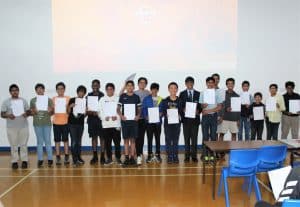 Suchira left QE to read Politics and International Studies at the University of Warwick, before securing a role as a consulting data analyst at the Information Lab. He said: “As a volunteer it was inspiring to see how engaged and active the students were in the competition, the out-of-the-box thinking, novel problem-solving and, in nearly every case, a board-worthy presentation!”
Suchira left QE to read Politics and International Studies at the University of Warwick, before securing a role as a consulting data analyst at the Information Lab. He said: “As a volunteer it was inspiring to see how engaged and active the students were in the competition, the out-of-the-box thinking, novel problem-solving and, in nearly every case, a board-worthy presentation!”
All four OEs commented on how much they had enjoyed being back at the School in person, observing that much had changed there in the past five years.
The three ‘companies’, Astrodyne Delta, Infinity Airspace and Solaris Flight Systems, were given a Request for Proposal (RFP) reflecting a typical design brief in the space engineering industry. They were asked to bid on a range of design modules: from the design of the command centre, to the power & energy generation, and the operations of the resort facility itself.
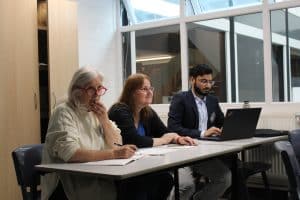 After trailing team Astrodyne Delta through the early stages of the competition, Solaris Flight Systems came through in the final stage to secure victory by the tightest of margins, winning contracts worth £320bn, against Astrodyne Delta’s £315bn. Infinity Airspace were not too far behind, on £300bn, with all three impressing the judges and securing contracts.
After trailing team Astrodyne Delta through the early stages of the competition, Solaris Flight Systems came through in the final stage to secure victory by the tightest of margins, winning contracts worth £320bn, against Astrodyne Delta’s £315bn. Infinity Airspace were not too far behind, on £300bn, with all three impressing the judges and securing contracts.
The judging panel comprised: Jenny Lyons, Director of Education at the Galactic Challenge; Alison Ahearn, Deputy Director of Education at the Galactic Challenge and Principal Teaching Fellow at Imperial College London; Headmaster Neil Enright; Gillian Ridge, Head of Biology; Tamara Rakviashvili, Science Technician, and Science teachers Bryn Evans, and J Murphy.
The designs were assessed in three stages over the day. Stages 1 and 2 were presented during the day to peers and judges, while Stage 3 was presented at the end of the day to parents, peers and the judging panel.

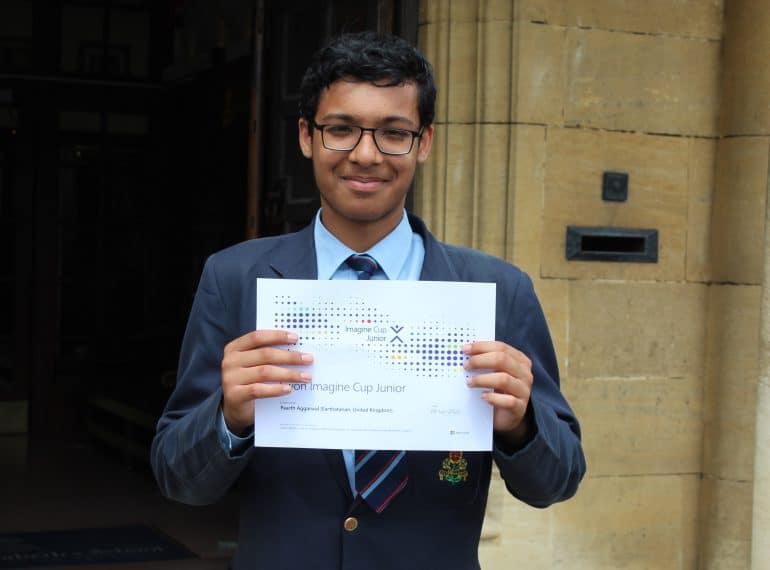
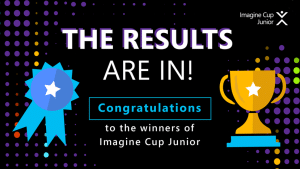 The competition, which challenged participants to submit creative ideas to solve some of the planet’s biggest issues using the power of artificial intelligence (AI), attracted thousands of entries from around the world.
The competition, which challenged participants to submit creative ideas to solve some of the planet’s biggest issues using the power of artificial intelligence (AI), attracted thousands of entries from around the world.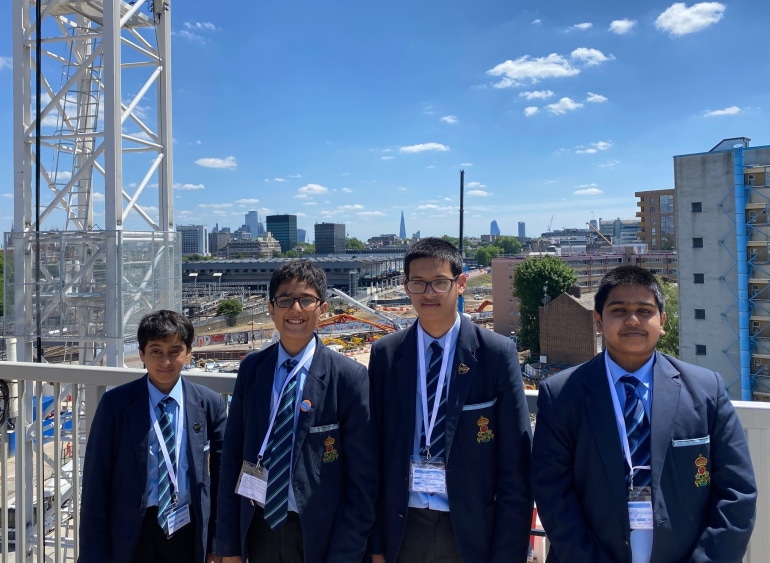
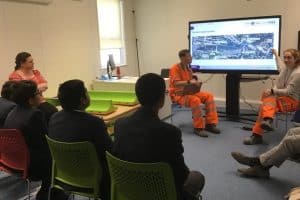 In the event, their visit was to one of the UK’s biggest current civil engineering sites. Euston Station will be the London terminus for HS2 and will double the seat capacity for trains leaving Euston during peak hours. The plans include a ‘seamless’ connection between the Northern, Victoria, Circle, Hammersmith and City and Metropolitan lines at Euston. The project forms part of a regeneration scheme in central London spanning 60 acres.
In the event, their visit was to one of the UK’s biggest current civil engineering sites. Euston Station will be the London terminus for HS2 and will double the seat capacity for trains leaving Euston during peak hours. The plans include a ‘seamless’ connection between the Northern, Victoria, Circle, Hammersmith and City and Metropolitan lines at Euston. The project forms part of a regeneration scheme in central London spanning 60 acres. “The trip to HS2 was fascinating and gave me a very useful insight into the day-to-day life of a civil engineer,” said Snehal. “I also learned how they impact our lives everyday by improving transport networks throughout the UK.’
“The trip to HS2 was fascinating and gave me a very useful insight into the day-to-day life of a civil engineer,” said Snehal. “I also learned how they impact our lives everyday by improving transport networks throughout the UK.’ 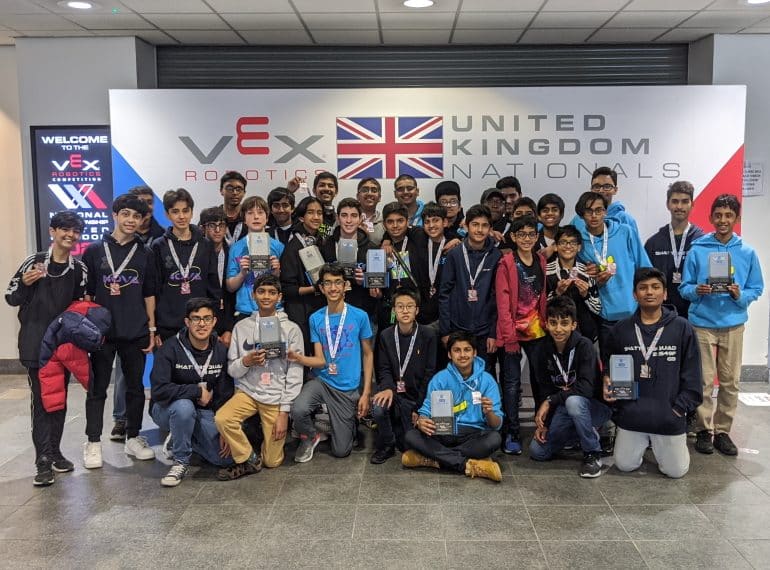
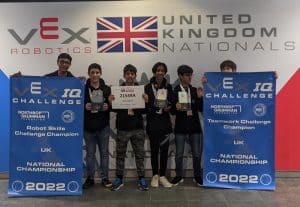 The six junior teams also won a slew of the top awards, following in the footsteps of the senior VRC teams who had similarly taken awards in their competition over the previous two days.
The six junior teams also won a slew of the top awards, following in the footsteps of the senior VRC teams who had similarly taken awards in their competition over the previous two days.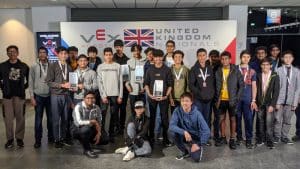 Four teams – two from Year 10, one from Year 12 and one with a mix of boys from the two year groups – competed in the senior VRC bracket at Telford International Center. HYBRID, Vortex Invicta, HEX Green and Hyperion pitted their wits against the very finest robotic talent in the UK. The VRC championships drew 58 teams from all over the UK to battle it out in the competition’s Brunel and Lovelace divisions.
Four teams – two from Year 10, one from Year 12 and one with a mix of boys from the two year groups – competed in the senior VRC bracket at Telford International Center. HYBRID, Vortex Invicta, HEX Green and Hyperion pitted their wits against the very finest robotic talent in the UK. The VRC championships drew 58 teams from all over the UK to battle it out in the competition’s Brunel and Lovelace divisions.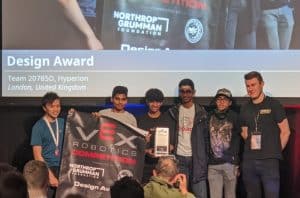 “Hyperion reached the Brunel divisional finals, while an all-QE alliance of HEX Green and HYBRID made it to the Lovelace division semi-final, only to be cruelly denied a finals place by a loose battery connection. The day was not over for QE teams, however: when the medal winners were announced, Hyperion won the coveted Design Award (considered the second-most prestigious in the whole competition), HEX Green achieved double success, winning both the Skills and Think awards, and Vortex Invicta received a Judges Award. “Vortex Invicta’s first award of the season thus arrived at the highest level of competition they had so far faced!” Mr Noonan said.
“Hyperion reached the Brunel divisional finals, while an all-QE alliance of HEX Green and HYBRID made it to the Lovelace division semi-final, only to be cruelly denied a finals place by a loose battery connection. The day was not over for QE teams, however: when the medal winners were announced, Hyperion won the coveted Design Award (considered the second-most prestigious in the whole competition), HEX Green achieved double success, winning both the Skills and Think awards, and Vortex Invicta received a Judges Award. “Vortex Invicta’s first award of the season thus arrived at the highest level of competition they had so far faced!” Mr Noonan said.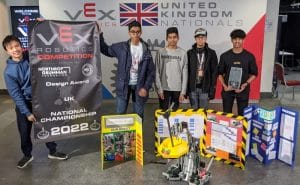 The achievements began with Gearsquad posting an early National Record Skills score. After strong QE performances in the Qualification and Skills elements of the competition, all eyes turned to the finals. The alliances (15 pairs from the 30 teams taken part) faced off in reverse order, from lowest to highest ranked, and the ‘Chair of Champions’ was unveiled – a seat reserved for the (current) highest-ranked teams.
The achievements began with Gearsquad posting an early National Record Skills score. After strong QE performances in the Qualification and Skills elements of the competition, all eyes turned to the finals. The alliances (15 pairs from the 30 teams taken part) faced off in reverse order, from lowest to highest ranked, and the ‘Chair of Champions’ was unveiled – a seat reserved for the (current) highest-ranked teams.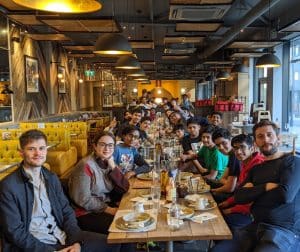 They also gained the following awards:
They also gained the following awards: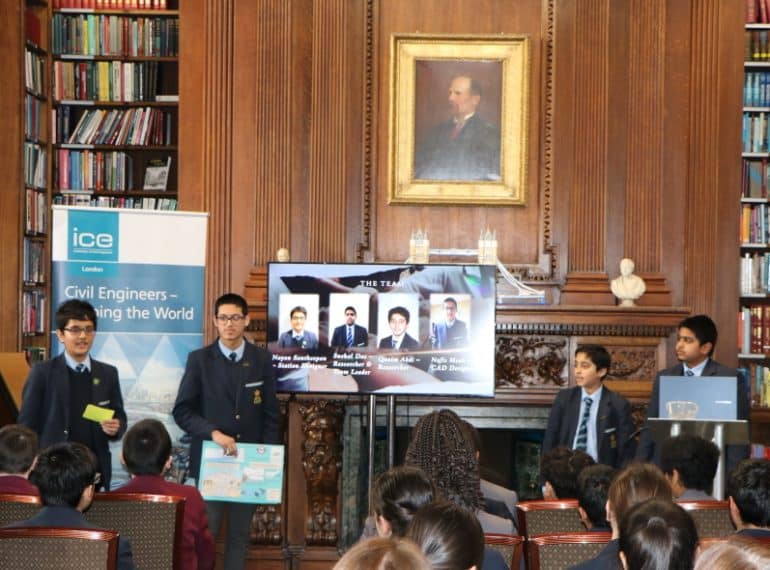
 The four Year 8 boys included no fewer than four different ways of reducing carbon emissions in their design for the new station connecting the Isle of Dogs to the O2 Arena in Greenwich.
The four Year 8 boys included no fewer than four different ways of reducing carbon emissions in their design for the new station connecting the Isle of Dogs to the O2 Arena in Greenwich.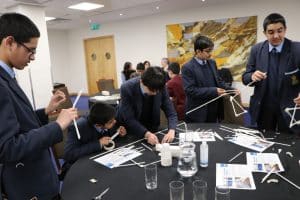 Jonathan Baggs, Director of ICE London, said that West Ferry was “very creative in its approach to energy generation and how it is used to operate the station”.
Jonathan Baggs, Director of ICE London, said that West Ferry was “very creative in its approach to energy generation and how it is used to operate the station”.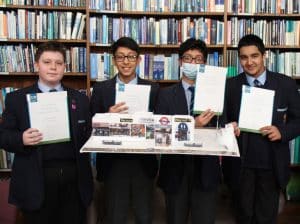 Kirsten Evans, a Technology technician and the organiser of the I Can Engineering Club at the School, congratulated all the boys who participated. “The club has allowed all 20 students involved to develop a better understanding of civil engineering’s role in society.”
Kirsten Evans, a Technology technician and the organiser of the I Can Engineering Club at the School, congratulated all the boys who participated. “The club has allowed all 20 students involved to develop a better understanding of civil engineering’s role in society.”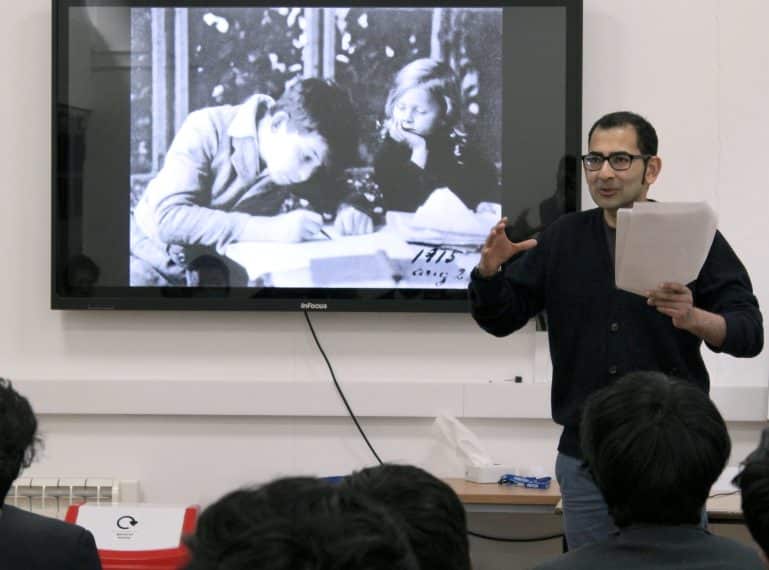
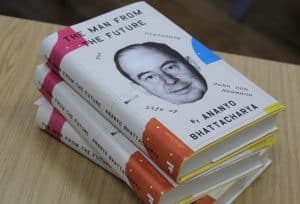 Dr Bhattacharya’s book, entitled The Man from the Future: The Visionary Life of John von Neumann, was named a Financial Times and Times Literary Supplement Book of the Year in 2021.
Dr Bhattacharya’s book, entitled The Man from the Future: The Visionary Life of John von Neumann, was named a Financial Times and Times Literary Supplement Book of the Year in 2021.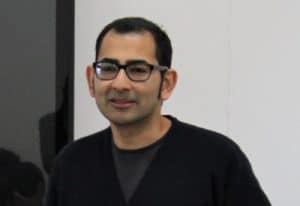 In his talk, Dr Bhattacharya mentioned the Manhattan Project as well as, inter alia, von Neumann’s contributions to set theory, game theory and the development of the first programmable digital computer.
In his talk, Dr Bhattacharya mentioned the Manhattan Project as well as, inter alia, von Neumann’s contributions to set theory, game theory and the development of the first programmable digital computer.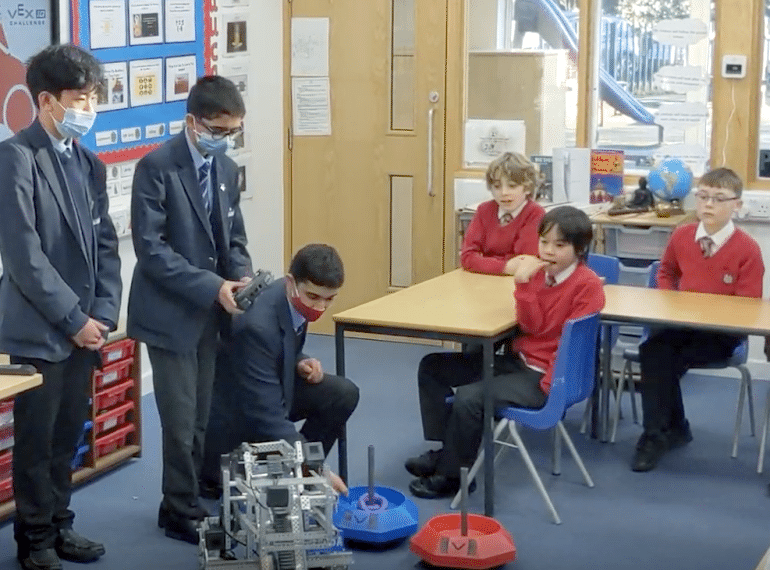
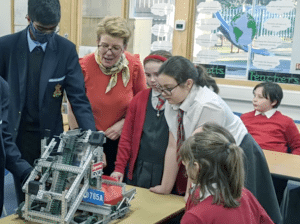 First, QE donated 3D printers to Northside Primary in North Finchley and Foulds School in Barnet, sending along a group of sixth-formers to help set the machines up and explain how they can be used.
First, QE donated 3D printers to Northside Primary in North Finchley and Foulds School in Barnet, sending along a group of sixth-formers to help set the machines up and explain how they can be used.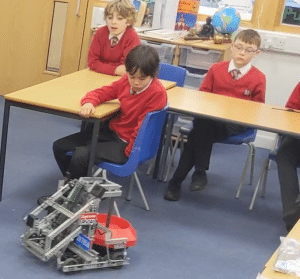 Mr Noonan accompanied senior boys from Team Hybrid – one of four senior QE robotics teams to have taken part in last year’s international VEX robotics finals – to Monkton Hadley.
Mr Noonan accompanied senior boys from Team Hybrid – one of four senior QE robotics teams to have taken part in last year’s international VEX robotics finals – to Monkton Hadley.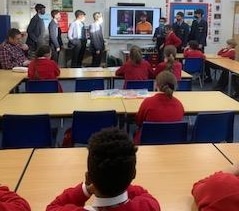 The children from Monken Hadley gave their own account in their school newsletter: “These robots were amazing…[The QE boys] play in many different competitions; the robot they are using…is so cool. It has a small conveyor belt, where rings go up, and it also collects big circles with poles on them.”
The children from Monken Hadley gave their own account in their school newsletter: “These robots were amazing…[The QE boys] play in many different competitions; the robot they are using…is so cool. It has a small conveyor belt, where rings go up, and it also collects big circles with poles on them.”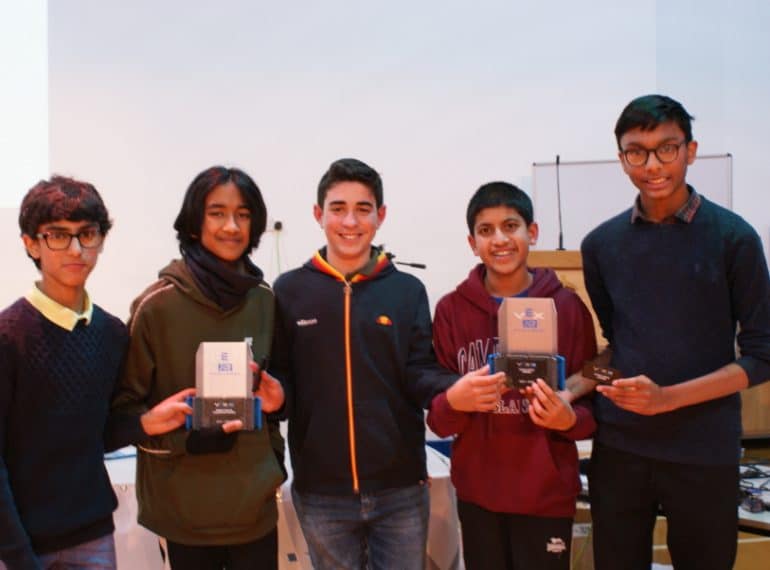
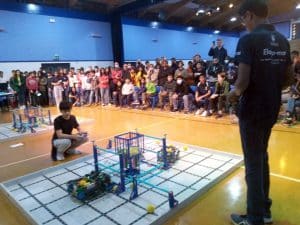 Thirty-two junior teams, including six from QE, took part in the North London Regional tournament, which QE hosted in the Shearly Hall.
Thirty-two junior teams, including six from QE, took part in the North London Regional tournament, which QE hosted in the Shearly Hall.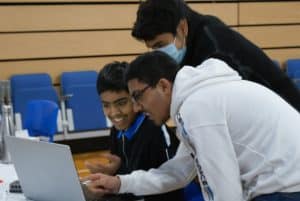 “However, it was a double alliance involving QE teams which pushed things forward in game 12 and 13. Firstly, a tournament high 78 being posted by a combination of QE newcomers Shattersquad and MTS Myopians, followed up by an even more impressive 83 posted by QE’s Year 9 Nova team and NUAST Triceratops. It was clear from this point on that the bar had been raised, with MTS Myopians in particular impressing. QE’s Gearsquad, Nova, and Cyberforce seemed to be battling it out behind them for the highest rankings spots, albeit the latter team were already securely qualified.
“However, it was a double alliance involving QE teams which pushed things forward in game 12 and 13. Firstly, a tournament high 78 being posted by a combination of QE newcomers Shattersquad and MTS Myopians, followed up by an even more impressive 83 posted by QE’s Year 9 Nova team and NUAST Triceratops. It was clear from this point on that the bar had been raised, with MTS Myopians in particular impressing. QE’s Gearsquad, Nova, and Cyberforce seemed to be battling it out behind them for the highest rankings spots, albeit the latter team were already securely qualified.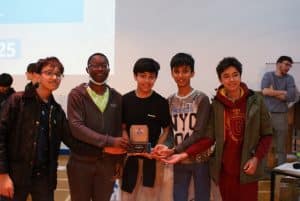 “In the end, it had appeared that Gearsquad had posted an unassailable score: a whopping 110 alongside the HBS Vextreme team. However, as was the case throughout the day, it was the pairing of Nova and MTS who would have the last laugh, and their incredible 125 score secured both teams their Tournament Champion title. The judges gave MTS X_O_Limit the Judges Award, and the Design Award was secured by HBS Spark.
“In the end, it had appeared that Gearsquad had posted an unassailable score: a whopping 110 alongside the HBS Vextreme team. However, as was the case throughout the day, it was the pairing of Nova and MTS who would have the last laugh, and their incredible 125 score secured both teams their Tournament Champion title. The judges gave MTS X_O_Limit the Judges Award, and the Design Award was secured by HBS Spark.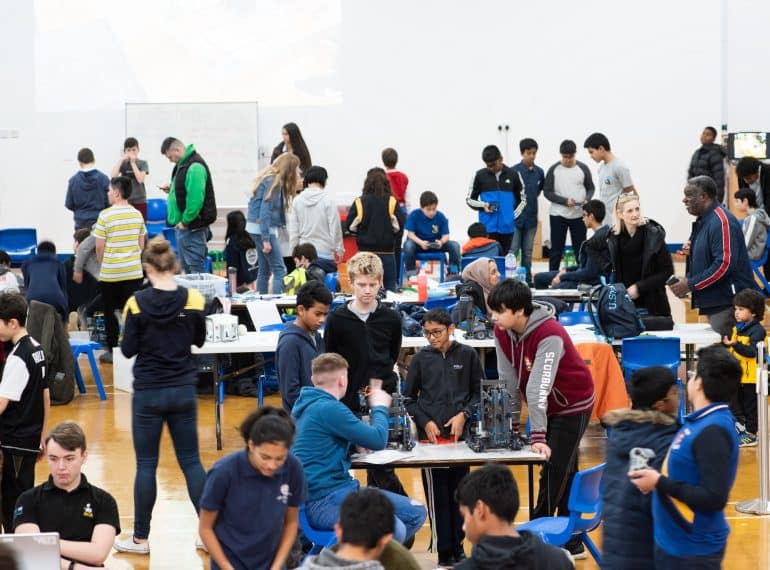
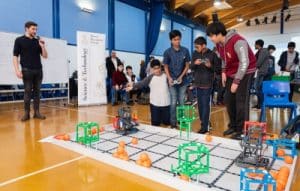 Head of Technology Michael Noonan said: “By the time they reached this competition, the boys definitely had the right mindset and the right strategy, having drawn on their past experience of robotics to develop a robot capable of taking on this season’s challenge. They handled the pressure on the day well and rightfully enjoyed the celebrations after their victory.”
Head of Technology Michael Noonan said: “By the time they reached this competition, the boys definitely had the right mindset and the right strategy, having drawn on their past experience of robotics to develop a robot capable of taking on this season’s challenge. They handled the pressure on the day well and rightfully enjoyed the celebrations after their victory.”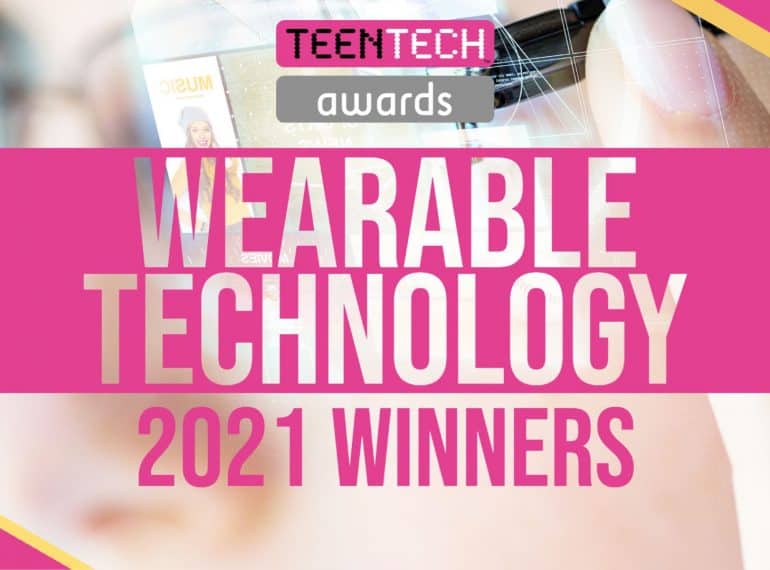
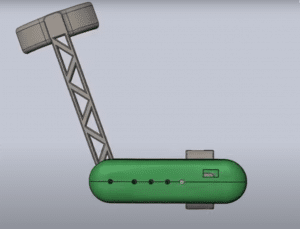 Anubhav Rathore and Heemy Kalam’s Flex-Charge – a device that harvests the energy of arm and leg movements to generate electricity – won the Wearable Technologies category of the 2021 TeenTech Awards.
Anubhav Rathore and Heemy Kalam’s Flex-Charge – a device that harvests the energy of arm and leg movements to generate electricity – won the Wearable Technologies category of the 2021 TeenTech Awards. The final was hosted by veteran technology reporter Maggie Philbin, CEO of the TeenTech educational charity, and included contributions from celebrities with ‘tech’ connections, including Professor Brian Cox, journalists Kate Russell and Rory Cellan-Jones, TV presenters LJ Rich and Dallas Campbell, Stephen McGann (Dr Turner in TV’s Call the Midwife), Dallas Campbell, and Dr Suzie Imber, Associate Professor in Space Physics at Leicester University.
The final was hosted by veteran technology reporter Maggie Philbin, CEO of the TeenTech educational charity, and included contributions from celebrities with ‘tech’ connections, including Professor Brian Cox, journalists Kate Russell and Rory Cellan-Jones, TV presenters LJ Rich and Dallas Campbell, Stephen McGann (Dr Turner in TV’s Call the Midwife), Dallas Campbell, and Dr Suzie Imber, Associate Professor in Space Physics at Leicester University.